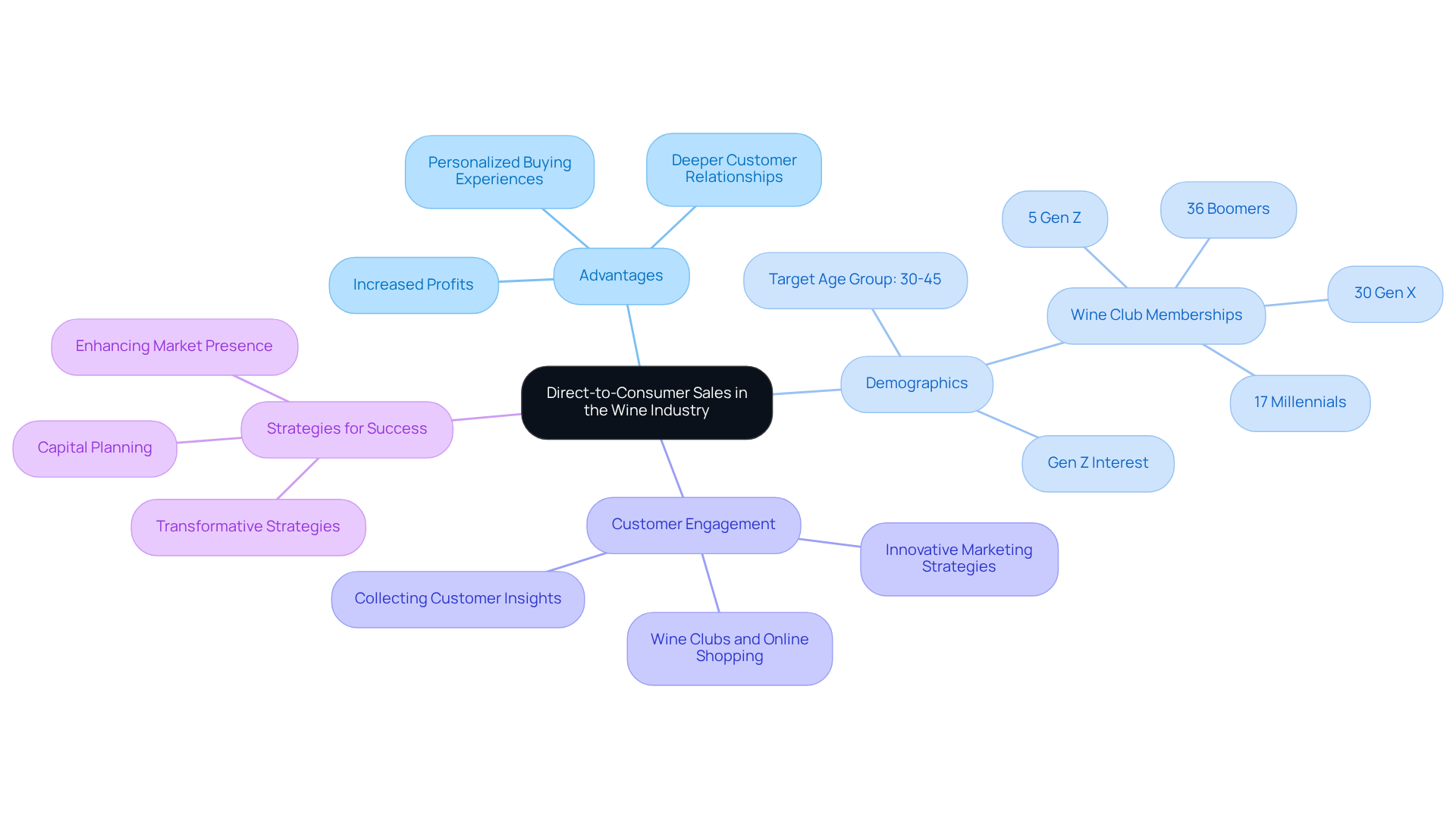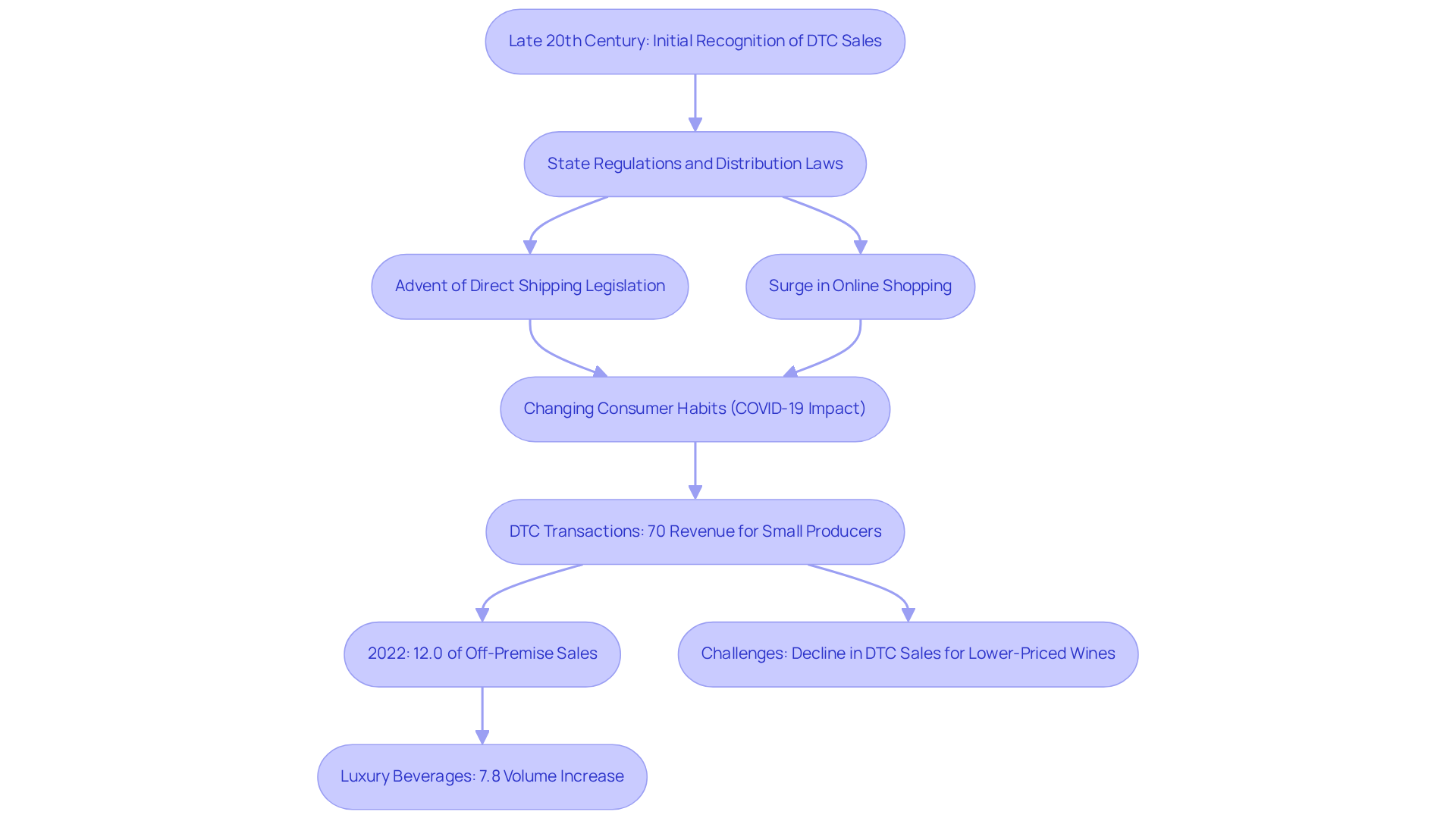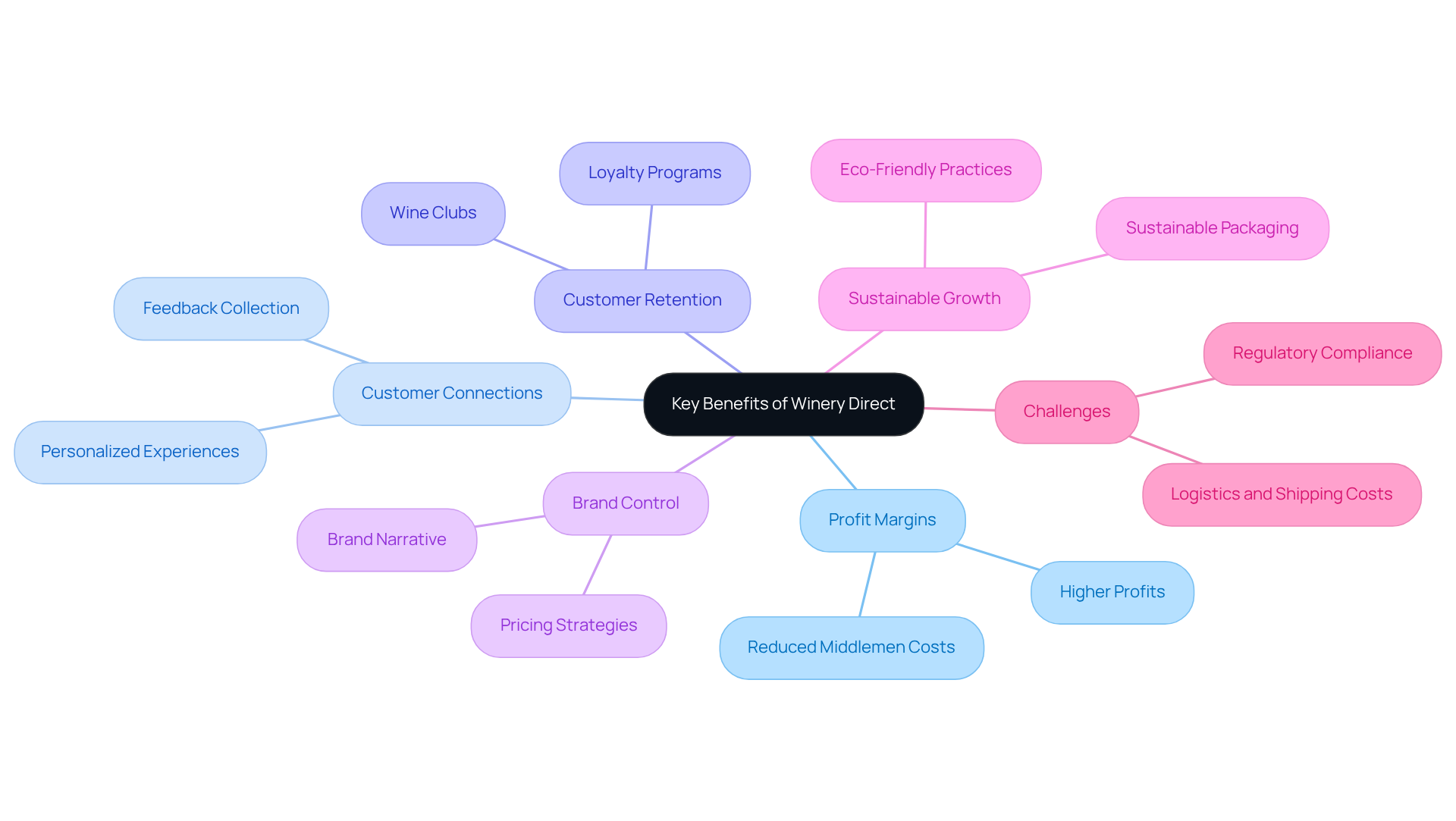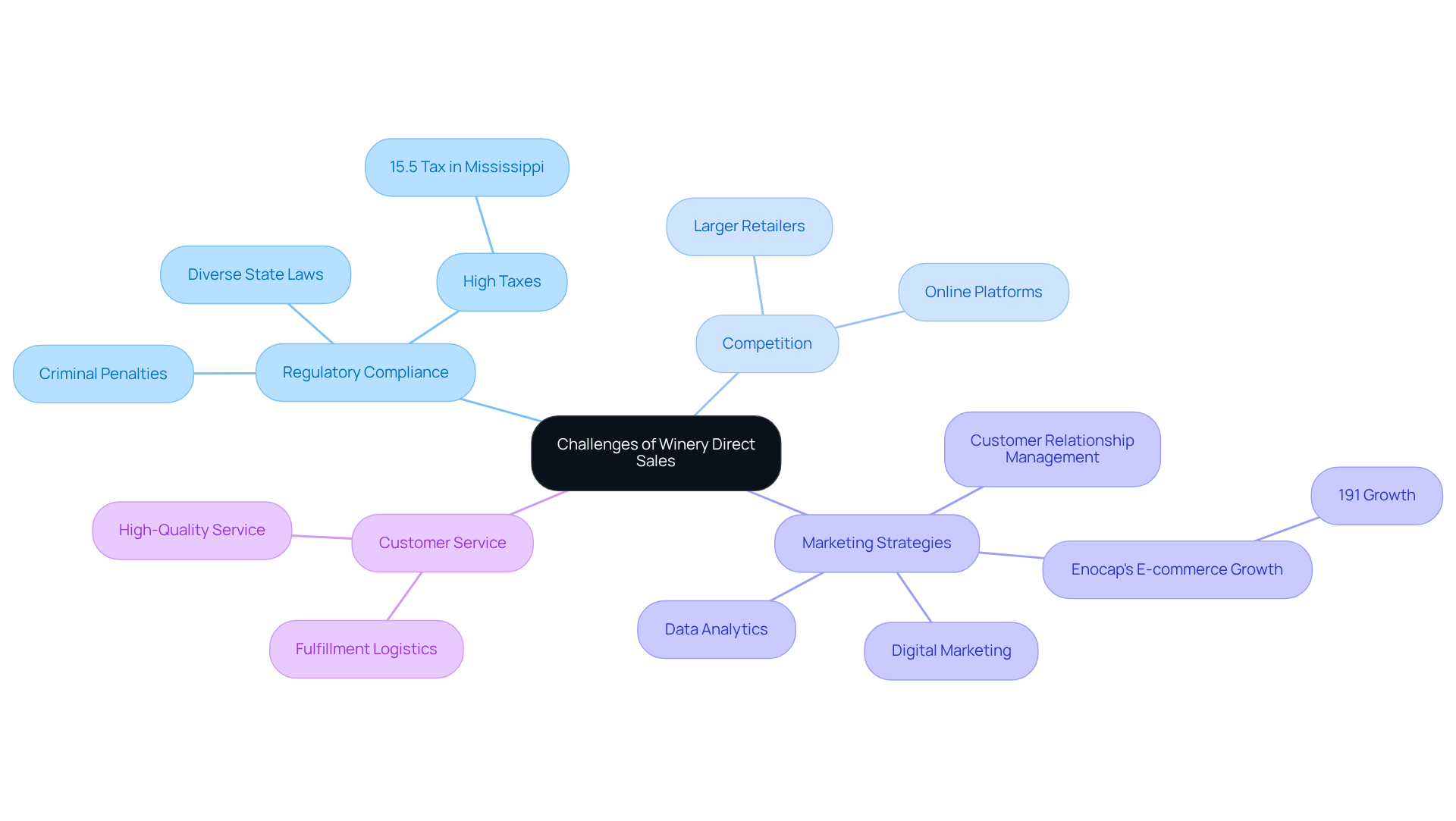Overview
This article delves into the concept of 'winery direct,' a term that signifies direct-to-consumer (DTC) sales within the wine industry. This model is not merely a trend; it is a pivotal strategy for wineries seeking to thrive in a competitive landscape. By embracing DTC sales, producers can significantly enhance their profit margins, foster robust customer relationships, and adeptly respond to evolving market dynamics. Notably, approximately 60-70% of revenue for small premium producers now originates from DTC transactions, illustrating a transformative shift within the industry. This evolution underscores the critical importance of adapting to consumer preferences and the potential for sustainable growth.
Introduction
The wine industry is experiencing a significant transformation as wineries increasingly adopt direct-to-consumer (DTC) sales. This shift is redefining how they connect with customers.
By eliminating middlemen, wineries not only enhance profitability but also cultivate deeper relationships with consumers, enabling personalized experiences and tailored marketing strategies.
However, as this landscape evolves, wineries confront a crucial question: How can they effectively navigate the complexities of DTC sales while maximizing their growth potential in an ever-competitive market?
Define Winery Direct: Understanding Direct-to-Consumer Sales in the Wine Industry
Direct-to-consumer (DTC) transactions signify a pivotal shift in the beverage sector, reflecting the winery direct meaning by empowering producers to sell their products directly to customers and bypass traditional distribution channels such as wholesalers and retailers. This model not only enables vineyards to retain a larger share of profits but also cultivates deeper customer relationships and personalized buying experiences, highlighting the winery direct meaning. DTC transactions can be executed through various channels, including tasting rooms, clubs, and online platforms, facilitating direct interaction with customers and helping to foster brand loyalty.
Currently, approximately 60% of vineyards are leveraging DTC distribution channels, acknowledging the winery direct meaning of the significant advantages they offer. For instance, wineries targeting the 30-to-45 age demographic have successfully implemented innovative marketing strategies that enhance customer engagement and drive revenue through clubs and online shopping. This demographic evolution is noteworthy, as 5% of wine club members are now Gen Z drinkers, reflecting a burgeoning interest among younger consumers.
The advantages of DTC sales extend beyond immediate financial returns. By forging direct connections with consumers, vineyards can collect invaluable insights into customer preferences and behaviors, which helps in understanding the winery direct meaning for tailored marketing strategies and enhanced product offerings. Industry leaders assert that the winery direct meaning of these direct relationships is vital for nurturing loyalty and retention, with numerous vineyards reporting increased membership in wine clubs and elevated average order values. Established strategies for generating consistent DTC income and transforming casual purchasers into committed club members are crucial for family-owned vineyards striving for success in a competitive landscape.
As Rob McMillan, founder of the Wine Division, observes, "Wineries brace for continuous headwinds," underscoring the necessity for innovative strategies to sustain competitiveness. The DTC model not only addresses current market challenges but also positions producers for sustainable growth in an ever-evolving landscape. By embracing DTC methodologies and implementing transformative strategies, including strategic capital planning, beverage producers can enhance their market presence and secure long-term success.

Contextualize Winery Direct: The Evolution of DTC Sales in the Wine Industry
The evolution of transactions reflecting winery direct meaning within the wine sector has its roots in the late 20th century, a period when producers began recognizing the immense potential of selling directly to customers. Initially constrained by state regulations and distribution laws, the model gained momentum as these laws evolved, particularly with the advent of direct shipping legislation. This legislative shift enabled producers to extend their reach beyond local markets.
The surge in online shopping, combined with changing consumer habits—especially during the COVID-19 crisis—accelerated the adoption of DTC transactions, transforming them into a crucial revenue stream for numerous vineyards. Currently, the winery direct meaning transactions account for nearly 70% of total revenue for the typical small premium producer, up from 60% in 2018. This shift signifies a broader trend toward personalized consumer experiences.
In 2022, the winery direct meaning of DTC shipments represented 12.0% of the total off-premise sales value of domestic beverages in the U.S., underscoring the model's growing importance. Additionally, the demand for luxury beverages priced at $100 or more has continued to rise, with DTC shipments of these products increasing by 7.8% in volume in 2022, following a remarkable growth of 34.2% in 2021.
However, it is critical to acknowledge that DTC sales have experienced a decline for the first time since the pandemic. Lower-priced wines, which constituted a significant portion of DTC shipments, saw a volume decrease of 17.5% in 2022 compared to 2021. This trend reflects a broader shift toward personalized consumer experiences, as wine producers adapt to evolving market dynamics and regulatory landscapes.
To thrive in this competitive arena, family-operated vineyards must embrace transformative DTC strategies that not only enhance customer retention but also secure strategic capital for sustainable development. By cultivating loyalty through optimized wine clubs and compelling brand storytelling, producers can strategically position themselves for ongoing success in the DTC market.

Explore Key Benefits: Advantages of Winery Direct for Wineries
The benefits of purchasing from vineyards, known as winery direct meaning, are extensive and significant. By removing middlemen, vineyards can attain considerably greater profit margins, which reflects the winery direct meaning of retaining a larger portion of income from each transaction.
Direct-to-consumer (DTC) transactions also foster stronger connections with consumers, enabling producers to gather valuable customer information and feedback that guide marketing strategies and product development, which exemplifies winery direct meaning.
Establishments utilizing effective DTC strategies frequently witness enhanced customer retention rates, with some indicating that loyalty program contributions represent approximately 24% of their yearly revenue. Moreover, DTC transactions allow vineyards to craft distinctive experiences through wine clubs and tailored marketing, enhancing the winery direct meaning and further boosting customer loyalty.
This approach not only results in higher average order values but also provides producers with greater control over their brand narrative and pricing strategies, allowing for swift responses to market changes.
Enocap emphasizes the importance of building sustainable DTC channels that drive consistent growth and transform casual buyers into loyal club members through proven strategies, including strategic capital planning to optimize resources for debt, equity, or acquisition opportunities.
However, wine producers must also navigate challenges such as logistics and shipping expenses, which can influence their direct-to-consumer revenue efforts. As the terrain of beverage distribution transforms, understanding the winery direct meaning and adopting DTC models becomes crucial for producers seeking to flourish in a competitive market.

Address Challenges: Navigating the Complexities of Winery Direct Sales
The benefits of transactions that embody winery direct meaning from vineyards are substantial; however, these establishments encounter numerous challenges that require meticulous management. A primary hurdle is compliance with the diverse state laws governing direct shipping, which complicates logistics and can increase operational costs. Recent developments in states like Mississippi underscore the complexities introduced by stringent regulations and significant taxes on wine sales, potentially discouraging producers from pursuing direct-to-consumer shipping.
Moreover, vineyards often find themselves competing against larger retailers and online platforms that leverage economies of scale to offer lower prices. This competitive landscape necessitates that vineyards develop robust marketing strategies to attract and retain customers in an increasingly crowded marketplace. Investing in digital marketing, customer relationship management, and data analytics is crucial for optimizing efforts that convey winery direct meaning to consumers. Enocap has successfully aided vineyards in achieving up to 191% e-commerce growth through the effective application of these strategies.
Additionally, maintaining high-quality customer service and efficiently managing fulfillment logistics are vital for ensuring a positive consumer experience. By proactively addressing these challenges with Enocap's tailored solutions, wineries can refine their direct sales strategies, ultimately fostering sustainable growth and enhancing the winery direct meaning of their market presence.

Conclusion
The exploration of winery direct meaning reveals a transformative approach within the wine industry, emphasizing the critical importance of direct-to-consumer (DTC) sales. By enabling wineries to connect directly with customers, this model not only enhances profitability but also fosters meaningful relationships essential for long-term success.
Key insights throughout the article highlight:
- The evolution of DTC sales
- The benefits of eliminating middlemen
- The challenges wineries face in navigating complex regulations and competition
The shift towards personalized consumer experiences has proven to be a significant driver of revenue, with many wineries reporting increased loyalty and higher average order values through effective DTC strategies.
As the landscape of the wine industry continues to evolve, embracing the winery direct model becomes increasingly vital. Wineries are encouraged to adopt innovative marketing strategies, enhance customer engagement, and leverage data analytics to thrive in a competitive environment. By doing so, they can secure sustainable growth and ensure their relevance in an ever-changing market.
Frequently Asked Questions
What does "winery direct" mean in the context of the wine industry?
"Winery direct" refers to direct-to-consumer (DTC) sales, allowing producers to sell their products directly to customers, bypassing traditional distribution channels like wholesalers and retailers.
What are the benefits of direct-to-consumer (DTC) sales for wineries?
DTC sales enable wineries to retain a larger share of profits, cultivate deeper customer relationships, and provide personalized buying experiences, which fosters brand loyalty.
Through what channels can wineries execute DTC transactions?
Wineries can execute DTC transactions through various channels, including tasting rooms, wine clubs, and online platforms.
How prevalent is the use of DTC distribution channels among vineyards?
Approximately 60% of vineyards are currently leveraging DTC distribution channels.
What demographic is increasingly engaging with DTC sales in the wine industry?
Wineries targeting the 30-to-45 age demographic have seen success, with a notable 5% of wine club members now being Gen Z drinkers.
How do DTC sales help wineries understand their customers better?
By forging direct connections with consumers, wineries can collect valuable insights into customer preferences and behaviors, which aids in developing tailored marketing strategies and enhanced product offerings.
Why are direct relationships with consumers important for wineries?
Direct relationships are vital for nurturing customer loyalty and retention, leading to increased membership in wine clubs and higher average order values.
What challenges do wineries face in the current market, according to industry leaders?
Wineries face continuous headwinds and must adopt innovative strategies to maintain competitiveness in a changing market.
What strategies can wineries implement to succeed with DTC sales?
Wineries can implement transformative strategies, including strategic capital planning and consistent income generation methods, to enhance market presence and secure long-term success.




